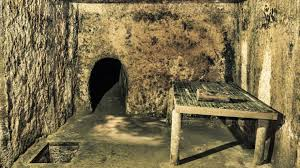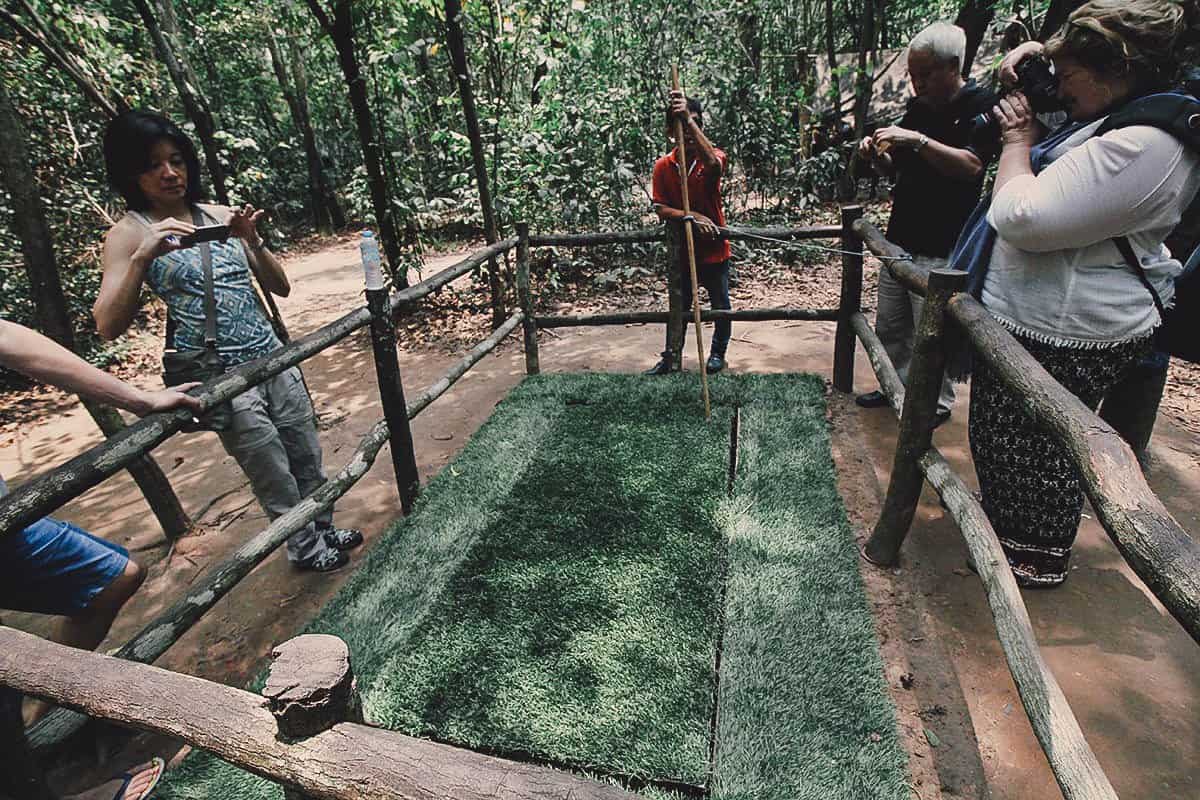Nestled just outside Ho Chi Minh City, the Cu Chi Tunnels offer a glimpse into Vietnam’s rich and complex history. These remarkable underground passages tell stories of resilience, strategy, and survival during one of the most tumultuous periods in the country’s past. As you venture through this labyrinthine network, you’ll uncover tales that have shaped not only Vietnam but also its people.

The tunnels are more than just a fascinating tourist attraction; they represent an enduring spirit against adversity. Travelers from around the globe flock to explore these hidden wonders of Vietnam. What awaits within is not only a journey into history but an adventure filled with wonder and discovery. Join us as we delve deeper into the allure of Cu Chi Tunnels—your gateway to understanding the intricacies of fascinating Vietnam!
Table of Contents
Historical Significance of Cu Chi Tunnels
The Cu Chi Tunnels are a remarkable testament to Vietnam’s resilience during the war. Built in the 1940s, they played a crucial role in the struggle against colonial forces and later against American troops.

The tunnels were first used by the Viet Minh, a communist guerrilla group, during their fight for independence from French colonial rule. They were expanded and improved upon by the Viet Cong, a communist group fighting against the South Vietnamese government and its allies during the Vietnam War.
The tunnels served as a base of operations for the Viet Cong, providing shelter, storage and communication networks throughout the region. They also played a strategic role in surprise attacks and ambushes against American troops.
The Cu Chi Tunnels became an important symbol of Vietnamese resistance and ingenuity during the war. They highlighted the determination of the Vietnamese people to defend their land against foreign invaders.
In addition to their military significance, the tunnels also had a significant impact on daily life for those living in Cu Chi. The complex network of tunnels provided refuge for locals during bombings and allowed them to continue their daily activities despite constant threat from enemy forces.
Today, the Cu Chi Tunnels serve as a tourist attraction and memorial site, offering visitors a glimpse into Vietnam’s past and its struggle for independence. They are also recognized as a UNESCO World Heritage Site, further highlighting their historical significance.
These tunnels served as hiding spots for soldiers, communication routes, and even storage facilities. Their intricate design allowed Vietnamese fighters to launch surprise attacks while remaining hidden from their enemies.
The ingenuity behind these underground networks is astounding. They extended over 250 kilometers and included living quarters, kitchens, and hospitals. This complexity ensured that life could continue amid conflict.
Visiting these tunnels offers insight into how resourcefulness can prevail in adversity. The stories etched into every corner reveal not just military strategy but also the spirit of those who lived there.
Layout and Features of the Tunnels
The Cu Chi Tunnels are an intricate underground network that stretches over 250 kilometers. This impressive labyrinth includes various levels and chambers, designed for both defense and daily life.
Visitors can explore narrow passages that were ingeniously crafted to accommodate the guerrilla fighters of the Vietnam War. Some sections are barely wide enough for a person to crawl through, highlighting the ingenuity required in such challenging conditions.
Features like trapdoors, living quarters, and storage areas showcase how these tunnels supported an entire community. Camouflaged entrances blended seamlessly into the jungle floor, making them nearly invisible to enemies above.
Additionally, ventilation shafts ensured fresh air circulated throughout long stretches of tunnel. Ingenious booby traps were strategically placed to deter any intruders trying to breach their hideout. Each aspect reveals a remarkable story of resilience and adaptation during one of history’s most tumultuous periods.
Life in the Tunnels during the Vietnam War
Life in the Cu Chi Tunnels was a stark contrast to the world above. These narrow underground passages became a refuge for many during the Vietnam War, offering shelter from relentless bombings and military operations.

Families lived in cramped quarters, sharing limited space while fostering an unbreakable community spirit. The tunnels housed not only soldiers but also women and children who contributed to survival efforts.
Daily life involved intricate routines. Residents farmed on nearby land, growing vegetables and rice whenever possible. They engaged in craft work, making tools and weapons essential for their fight.
Communication was key; whispers echoed through the tunnels as strategies were devised under cover of darkness. Innovation flourished here—traps concealed within foliage kept enemies at bay while clever ventilation systems ensured fresh air circulated throughout this subterranean labyrinth.
Amidst fear and uncertainty, resilience thrived within these walls—a testament to human endurance against adversity.
Tourist Attractions at Cu Chi Tunnels
Visitors to the Cu Chi Tunnels are often captivated by the rich history intertwined with each underground passage. One of the main attractions is the extensive tunnel system itself, which stretches over 250 kilometers.
Walking through these narrow pathways offers a firsthand glimpse into life during wartime.
In addition to the tunnels, there are several other tourist attractions at Cu Chi including:
1. Shooting Range: Visitors can test their shooting skills by firing an AK-47 or M16 rifle at the on-site shooting range. This is a popular activity for tourists, although some may find it controversial due to the violent nature of these weapons.
2. Documentary Film Screening: A short documentary film is screened for visitors before entering the tunnels. This film provides historical context and background information about the Cu Chi Tunnels.
3. Tunnel Crawl: For a more immersive experience, visitors can crawl through a section of the tunnels that have been widened and reinforced for tourists. This gives a sense of what it was like for soldiers who lived and fought in the narrow underground passages.
4. Traps Display: The Cu Chi Tunnels were not only used as hiding spots and supply routes, but also had an intricate network of traps designed to harm or kill enemy soldiers. Visitors can see examples of these traps on display throughout the site.
5. Hoang Cam Kitchen: The Hoang Cam Kitchen was an important area within the tunnel system where food was prepared for soldiers. Visitors can see this kitchen and learn about the methods used to cook meals while remaining
Nearby, you’ll find an array of war relics, including booby traps and weaponry used by soldiers. These exhibits provide a stark reminder of the ingenuity and resilience exhibited during those challenging times.
Don’t miss out on the opportunity to experience traditional Vietnamese cuisine at local eateries near the site. Savoring dishes like rice paper rolls or steaming pho adds another layer to your adventure in this fascinating destination.
For thrill-seekers, there’s also a chance to fire real weapons at designated ranges—an adrenaline-pumping way to connect with history while immersing yourself in Vietnam’s intriguing past.
Tips for Visiting the Cu Chi Tunnels
When visiting the Cu Chi Tunnels, wear comfortable shoes. The terrain can be uneven and navigating through the tunnels requires agility.
Consider going early in the day to avoid larger crowds. This way, you can explore at your own pace and soak in the history without distractions.
Be prepared for hot and humid weather. Bring water, sunscreen, and a hat to protect yourself from the sun.
Listen carefully to your tour guide’s instructions before entering the tunnels. They will provide important safety information and tips for navigating through the tunnels.
Bring insect repellent as there may be bugs in the area. Be respectful of the site and its historical significance. Avoid touching or removing any artifacts or relics.
Take photos but also take time to appreciate the history and significance of the site. Be mindful of other visitors and avoid obstructing their views or experiences.
If you choose to crawl through the tunnels, do it at your own comfort level. It’s not necessary to go all the way through if you are uncomfortable.
Visit nearby museums or watch a documentary beforehand to learn more about the history of the Cu Chi Tunnels.
Be respectful of the site and its significance. This was a place where many people lost their lives during the Vietnam War.
Consider booking a guided tour with a reputable company. They can provide valuable insights and information about the site.
Don’t touch any objects or structures within the tunnels without permission. Some areas may be sensitive or dangerous.
Bring some water along to stay hydrated. The heat can be intense, especially during midday tours.
Don’t forget your camera! Capture the unique features of these historical sites while respecting the rules around photography.
Engage with local guides. They provide valuable insights that enhance your understanding of this remarkable place and its significance during wartime.
Conclusion: Why You Should Visit Cu Chi Tunnels
Visiting the Cu Chi Tunnels offers an unparalleled glimpse into Vietnam’s rich and complex history. This network of tunnels provides a unique perspective on how ingenuity and resilience shaped the lives of those who lived there during turbulent times.
Exploring this vast underground world is not just about witnessing historical artifacts; it’s about understanding the stories behind them. The experience deepens your appreciation for the sacrifices made by many individuals during the Vietnam War. You’ll leave with more than just memories; you will carry insights that resonate well beyond your visit.
The Cu Chi Tunnels are easily accessible from Ho Chi Minh City, making them a must-see destination for anyone traveling through fascinating Vietnam. Embrace this opportunity to connect with history while enjoying a captivating adventure in one of Asia’s most intriguing locales. The highlights of Cu Chi Tunnels promise to be unforgettable, ensuring that every moment spent here is worthwhile.
Click here for more details.
Stay tuned on Travelyas for related details.

